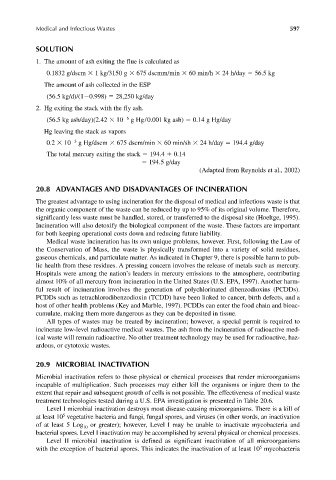Page 626 - Materials Chemistry, Second Edition
P. 626
CAT3525_C20.qxd 1/27/2005 12:54 PM Page 597
Medical and Infectious Wastes 597
SOLUTION
1. The amount of ash exiting the flue is calculated as
0.1832 g/dscm 1 kg/3150 g 675 dscmm/min 60 min/h 24 h/day 56.5 kg
The amount of ash collected in the ESP
(56.5 kg/d)/(1 0.998) 28,250 kg/day
2. Hg exiting the stack with the fly ash.
(56.5 kg ash/day)(2.42 10 6 g Hg/0.001 kg ash) 0.14 g Hg/day
Hg leaving the stack as vapors
0.2 10 3 g Hg/dscm 675 dscm/min 60 min/sh 24 h/day 194.4 g/day
The total mercury exiting the stack 194.4 0.14
194.5 g/day
(Adapted from Reynolds et al., 2002)
20.8 ADVANTAGES AND DISADVANTAGES OF INCINERATION
The greatest advantage to using incineration for the disposal of medical and infectious waste is that
the organic component of the waste can be reduced by up to 95% of its original volume. Therefore,
significantly less waste must be handled, stored, or transferred to the disposal site (Hoeltge, 1995).
Incineration will also detoxify the biological component of the waste. These factors are important
for both keeping operational costs down and reducing future liability.
Medical waste incineration has its own unique problems, however. First, following the Law of
the Conservation of Mass, the waste is physically transformed into a variety of solid residues,
gaseous chemicals, and particulate matter. As indicated in Chapter 9, there is possible harm to pub-
lic health from these residues. A pressing concern involves the release of metals such as mercury.
Hospitals were among the nation’s leaders in mercury emissions to the atmosphere, contributing
almost 10% of all mercury from incineration in the United States (U.S. EPA, 1997). Another harm-
ful result of incineration involves the generation of polychlorinated dibenzodioxins (PCDDs).
PCDDs such as tetrachlorodibenzodioxin (TCDD) have been linked to cancer, birth defects, and a
host of other health problems (Key and Marble, 1997). PCDDs can enter the food chain and bioac-
cumulate, making them more dangerous as they can be deposited in tissue.
All types of wastes may be treated by incineration; however, a special permit is required to
incinerate low-level radioactive medical wastes. The ash from the incineration of radioactive med-
ical waste will remain radioactive. No other treatment technology may be used for radioactive, haz-
ardous, or cytotoxic wastes.
20.9 MICROBIAL INACTIVATION
Microbial inactivation refers to those physical or chemical processes that render microorganisms
incapable of multiplication. Such processes may either kill the organisms or injure them to the
extent that repair and subsequent growth of cells is not possible. The effectiveness of medical waste
treatment technologies tested during a U.S. EPA investigation is presented in Table 20.6.
Level I microbial inactivation destroys most disease-causing microorganisms. There is a kill of
5
at least 10 vegetative bacteria and fungi, fungal spores, and viruses (in other words, an inactivation
of at least 5 Log or greater); however, Level I may be unable to inactivate mycobacteria and
10
bacterial spores. Level I inactivation may be accomplished by several physical or chemical processes.
Level II microbial inactivation is defined as significant inactivation of all microorganisms
5
with the exception of bacterial spores. This indicates the inactivation of at least 10 mycobacteria

